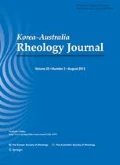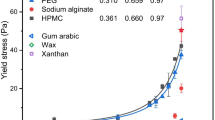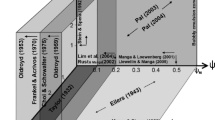Abstract
The suspensions and emulsions are important products and raw materials for various industrial production and processing branches. The knowledge concerning the rheological properties of such substances is of key importance for many manufacturing processes. Many dependences can be found within the literature but there is lack of model that takes into account the influence of inner phase concentration, share rate, and diameters of the dispersed phase particles on a viscosity of these systems. The presented work goal was to obtain a rheological equation containing the modified form of Peclet number, which would provide the relation between the viscosity, the volume fraction, and the shear rate. The theory of Kozeny-Carman, which transforms the granular structure into a bunch of the torturous capillary tubes, was the base of this model. The proposed model has been verified for data available in the literature and for the data obtained in authors own experiments.
Similar content being viewed by others
References
Anvari, M. and H.S. Joyner, 2017, Effect of formulation on structure-function relationships of concentrated emulsions: Rheological, tribological, and microstructural characterization, Food Hydrocolloids 72, 11–26.
Aomari, N., R. Gaudu, F. Cabioc, and A. Omari, 1998, Rheology of water in crude oil emulsions, Colloid Surf. A-Physicochem. Eng. Asp. 139, 13–20.
Ariffin, T.S.T., E. Yahya, and H. Husin, 2016, The rheology of light crude oil and water-in-oil-emulsion, Procedia Eng. 148, 1149–1155.
Avazmohammadi, R. and P.P. Castaneda, 2016, Macroscopic rheological behavior of suspensions of soft solid particles in yield stress fluids, J. Non-Newton. Fluid Mech. 234, 139–161.
Böttcher, S., J.K. Keppler, and S. Drusch, 2017, Mixtures of Quillaja saponin and beta-lactoglobulin at the oil/water-interface: Adsorption, interfacial rheology and emulsion properties, Colloid Surf. A-Physicochem. Eng. Asp. 518, 46–56.
Carreau, P.J., D.C.R. De Kee, and R.P. Chhabra, 1997, Rheology of Polymeric Systems: Principles and Applications, Hanser, New York.
Casson, N.A., 1959, A flow equation for pigment oil suspensions of the printing ink type, In: Mill, C.C., eds., Rheology of Disperse Systems, Pergamon Press, Oxford, 84–104.
Castel, V., A.C. Rubiolo, and C.R. Carrara, 2017, Droplet size distribution, rheological behavior and stability of corn oil emulsions stabilized by a novel hydrocolloid (Brea gum) compared with gum arabic, Food Hydrocolloids 63, 170–177.
Ching, S.H., N. Bansal, and B. Bhandari, 2016, Rheology of emulsion-filled alginate microgel suspensions, Food Res. Int. 80, 50–60.
Cohen-Addad, S. and R. Höhler, 2014, Rheology of foams and highly concentrated emulsions, Curr. Opin. Colloid Interface Sci. 19, 536–548.
Cross, M.M., 1965, Rheology of non-Newtonian fluids: A new flow equation for pseudoplastic systems, J. Colloid Sci. 20, 417–437.
dos Santosa, R.G., A.C. Watson, and W. Loh, 2014, Phase segregation, shear thinning and rheological behavior of crude oil-in-water emulsions, Chem. Eng. Res. Des. 92, 1629–1636.
Herschel, W.H. and R. Bulkley, 1926, Konsistenzmessungen von Gummi-Benzollösungen, Colloid Polym. Sci. 39, 291–300.
Huang, L. and M. Petermann, 2015, An experimental study on rheological behaviors of paraffin/water phase change emulsion, Int. J. Heat Mass Transf. 83, 479–486.
Kemblowski, Z., M. Dziubiński, and J.P. Sek, 1987, Flow of non-Newtonian fluids through granular media, In: Mashelkar, R.A., A.S. Mujumdar, and M.R. Kamal, eds., Advances in Transport Processes, Vol. 5, Wiley Eastern Ltd., New Delhi, 117–175.
Krieger, I.M., 1972, Rheology of monodisperse latices, Adv. Colloid Interface Sci. 3, 111–136.
Krieger, I.M. and T.J. Dougherty, 1959, A mechanism for non-Newtonian flow in suspensions of rigid spheres, J. Rheol. 3, 137–152.
Laba, D., 1993, Rheological Properties of Cosmetics and Toiletries, CRC Press, New York.
Lorenzo, G., N. Zaritzky, and A. Califano, 2008, Modeling rheological properties of low-in-fat o/w emulsions stabilized with xanthan/guar mixtures, Food Res. Int. 41, 487–494.
Mader, H.M., E.W. Llewellin, and S.P. Mueller, 2013, The rheology of two-phase magmas: A review and analysis, J. Volca-nol. Geother. Res. 257, 135–158.
Meriem-Benziane, M., S.A. Abdul-Wahab, M. Benaicha, and M. Belhadri, 2012, Investigating the rheological properties of light crude oil and the characteristics of its emulsions in order to improve pipeline flow, Fuel 95, 97–107.
Mooney, M., 1951, The viscosity of a concentrated suspension of spherical particles, J. Colloid Sci. 6, 162–170.
Mougel, J., O. Alvarez, C. Baravian, F. Caton, P. Marchal, M.J. Stebe, and L. Choplin, 2006, Aging of an unstable w/o gel emulsion with a nonionic surfactant, Rheol. Acta 45, 555–560.
Mueller, S., E.W. Llewellin, and H.M. Mader, 2009, The rheology of suspensions of solid particles, Proc. R. Soc. A-Math. Phys. Eng. Sci. 466, 1201–1228.
Ostwald, W., 1929, Ueber die rechnerische Darstellung des Strukturgebietes der Viskosität, Colloid Polym. Sci. 47, 176–187.
Pajouhandeh, A., A. Kavousi, M. Schaffie, and M. Ranjbar, 2017, Experimental measurement and modeling of nanoparticle-stabilized emulsion rheological behavior, Colloid Surf. A-Physicochem. Eng. Asp. 520, 597–611.
Princen, H.M. and A.D. Kiss, 1986, Rheology of foams and highly concentrated emulsions: III. Static shear modulus, J. Colloid Interface Sci. 112, 427–437.
Qiao, X., L. Wang, Z. Shao, K. Sun, and R. Miller, 2015, Stability and rheological behaviors of different oil/water emulsions stabilized by natural silk fibroin, Colloid Surf. A-Physicochem. Eng. Asp. 475, 84–93.
Savage, R.M., 2000, Effects of rheology modifiers on the flow curves of idealised and food suspensions, Food Hydrocolloids 14, 209–215.
Sharu, B.K., G.P. Simon, W. Cheng, J. Zank, and A.R. Bhattacharyya, 2017, Development of microstructure and evolution of rheological characteristics of a highly concentrated emulsion during emulsification, Colloid Surf. A-Physicochem. Eng. Asp. 532, 342–350.
Sisko, A.W., 1958, The flow of lubricating greases, Ind. Eng. Chem. 50, 1789–1792.
Sochi, T., 2009, Single-phase flow of non-Newtonian fluids in porous media, Technical Report arXiv: 0907.2399v1.
Taborda, E.A., C.A. Franco, S.H. Lopera, V. Alvarado, and F.B. Cortés, 2016, Effect of nanoparticles/nanofluids on the rheology of heavy crude oil and its mobility on porous media at reservoir conditions, Fuel 184, 222–232.
Tripathi, S., A. Bhattacharya, R. Singh, and R.F. Tabor, 2017, Rheological behavior of high internal phase water-in-oil emulsions: Effects of droplet size, phase mass fractions, salt concentration and aging, Chem. Eng. Sci. 174, 290–301.
Whitby, C.P. and P.C. Garcia, 2014, Time-dependent rheology of clay particle-stabilised emulsions, Appl. Clay Sci. 96, 56–59.
Zadymova, N.M., Z.N. Skvortsova, V.Y. Traskine, F.A. Kulikov-Kostyushko, V.G. Kulichikhin, and A.Y. Malkin, 2017, Rheological properties of heavy oil emulsions with different morphologies, J. Pet. Sci. Eng. 149, 522–530.
Zhang, X., J.Y. Wu, and J. Niu, 2016, PCM-in-water emulsion for solar thermal applications: The effects of emulsifiers and emulsification conditions on thermal performance, stability and rheology characteristics, Sol. Energy Mater. Sol. Cells 147, 211–224.
Author information
Authors and Affiliations
Corresponding author
Rights and permissions
About this article
Cite this article
Sęk, J.P., Błaszczyk, M.M. & Przybysz, Ł. A rheological model to predict viscosity of dispersions as a function of the modified Peclet number. Korea-Aust. Rheol. J. 31, 81–88 (2019). https://doi.org/10.1007/s13367-019-0009-2
Received:
Revised:
Accepted:
Published:
Issue Date:
DOI: https://doi.org/10.1007/s13367-019-0009-2




